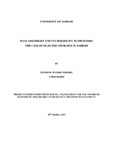| dc.description.abstract | This research was set to study mass assemblies and disaster preparedness in churches in Nairobi.
In the study, the awareness, knowledge and abilities of the church leaders and members with
regard to disaster management was studied. The study was conducted in six churches within
Nairobi which were purposively selected and these represented all churches as they are a forum
of mass assemblies.
The general objective of the study was to establish the extent to which disaster management had
been incorporated in places of mass assemblies. Specifically, the study sought to find out if the
church leaders and members were aware of the threats that provided a fertile ground for panic
and hysteria which surrounded their mass assembly and how they were likely to behave should
these hazards be triggered. The study also sought to establish the knowledge that the church
leaders and members had of the likely hazards in a mass assembly and how they were likely to
respond. An assessment of the contingency measures which the churches had put in place in
response preparedness to the likely hazards was also done.
Non probability sampling was used to obtain the sample for the study. Purposive sampling
method was used to select the 6 churches under study and the 6leaders interviewed were
obtained from these churches. The Quota sampling method was used in selecting a sample of
145 church members from the 6 churches under study. These participants were interviewed using
an interview schedule. Observation of the selected churches was also done.
The responses obtained were analyzed and discussed in line with the common themes of the
study. The data collected is presented in frequency distribution tables. The data collected
revealed that a large percentage of the church of the members were unaware of hazards that surrounded their churches. Where there was awareness, the researcher established that some
response actions had been taken to respond to some of the hazards.
The researcher further established that the leaders and members had some knowledge on likely
hazards in a mass assembly. The likely hazards studied were Stampede, Fire, Fainting, Armed
Intruder, Terrorist scare and Terrorist Attack. The need for awareness creation and education on
the church community on likely hazards and the recommended response was established.
An assessment of the contingency measures in place in the churches revealed some gaps which
are important in responding to disasters. The churches lacked some basic measures like
conducting emergency drills, contracts with and contacts of service providers like the fire
fighters, ambulance services and first aid services. However, all the churches under study had
engaged security firms in order to ensure that security screening was conducted at the entry of
the churches.
On observation, the churches were found to be lacking in providing adequate entry and exit
avenues. The structural designs of the churches enhanced the vulnerability of the assemblies in
these churches to likely hazards like congestion and stampedes. None of the churches under
study had taken into consideration physically challenged people in their structural designs and
this limited the number of people with disabilities who were able to access the churches.
The researcher recommends training of church leaders on disaster management, awareness
creation and regular educative sessions for the church members on the subject of disaster
management.
The findings of this study will be shared with the church leaders and members who participated
in the study and will be extended to other churches. | en_US |

